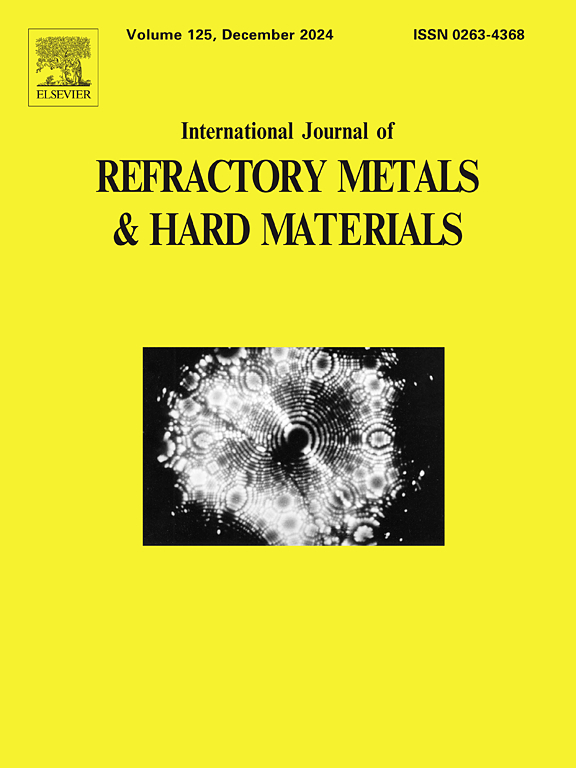原位激光重熔(Ni/Ni3B + WC) + NiCrFeBSiC火焰喷涂涂层的显微组织演变
IF 4.2
2区 材料科学
Q2 MATERIALS SCIENCE, MULTIDISCIPLINARY
International Journal of Refractory Metals & Hard Materials
Pub Date : 2025-05-12
DOI:10.1016/j.ijrmhm.2025.107231
引用次数: 0
摘要
本文介绍了通过在涂层系统中添加Metco 15E (NiCrFeBSiC)子层,在下一次激光重熔中改性火焰喷涂DURMAT 61-PTA (NiFeSiB + WC/W2C)涂层的显微组织变化的研究结果。这种改性旨在增加大的、高熔点的、坚硬的碳化钨与基体材料的附着力,并促进和控制涂层的激光重熔。对改性后的涂层进行了显微组织分析,包括化学成分、物相组成和硬度评定。结果表明,激光熔覆后层状(改性)涂层的硬度显著提高,超过了混合物的可加性规律。这表明与两种输入材料的相互影响有关的显著协同效应。研究表明,使硬度提高到61 HRC左右的作用是产生了硼化钨作为必要的强化相。硼化物相的原位形成可能是由于碳化钨在基体中的初次溶解和各种类型的硼化钨的二次形成。所观察到的协同效应是使用上述分层涂层技术概念的本质好处,这有助于制备基于碳化钨的具有技术挑战性的多相涂层。本文章由计算机程序翻译,如有差异,请以英文原文为准。
The microstructure evolution of in-situ laser remelted of (Ni/Ni3B + WC) + NiCrFeBSiC flame-sprayed coating
This article presents research results related to microstructural changes in modified flame-sprayed DURMAT 61-PTA (NiFeSiB + WC/W2C) coating by introducing additional Metco 15E (NiCrFeBSiC) sublayers into the coating system with next laser remelting. This modification aimed to increase the adhesion of the large, high-melting and hard tungsten carbides to the substrate material and to facilitate and control the laser remelting of the coating. The modified coating was subjected to microstructural analysis regarding chemical and phase composition and hardness assessment. It was shown that the hardness of the layered (modified) coating after the laser melting process increased significantly, exceeding the additivity rules for mixtures. This suggests a noticeable synergy effect related to the mutual influence of both input materials. The research indicates that the effect responsible for the increase in hardness to approximately 61 HRC was the generation of tungsten borides as an essential strengthening phase. The probable in-situ formation of boride phases results from the primary dissolution of tungsten carbides in the matrix and the secondary formation of tungsten borides of various types. The observed synergistic effect is the essential benefit of using the above-mentioned technological concept of layered coatings, which is proposed to facilitate the preparation of technologically challenging coatings containing many phases based on tungsten carbide.
求助全文
通过发布文献求助,成功后即可免费获取论文全文。
去求助
来源期刊
CiteScore
7.00
自引率
13.90%
发文量
236
审稿时长
35 days
期刊介绍:
The International Journal of Refractory Metals and Hard Materials (IJRMHM) publishes original research articles concerned with all aspects of refractory metals and hard materials. Refractory metals are defined as metals with melting points higher than 1800 °C. These are tungsten, molybdenum, chromium, tantalum, niobium, hafnium, and rhenium, as well as many compounds and alloys based thereupon. Hard materials that are included in the scope of this journal are defined as materials with hardness values higher than 1000 kg/mm2, primarily intended for applications as manufacturing tools or wear resistant components in mechanical systems. Thus they encompass carbides, nitrides and borides of metals, and related compounds. A special focus of this journal is put on the family of hardmetals, which is also known as cemented tungsten carbide, and cermets which are based on titanium carbide and carbonitrides with or without a metal binder. Ceramics and superhard materials including diamond and cubic boron nitride may also be accepted provided the subject material is presented as hard materials as defined above.

 求助内容:
求助内容: 应助结果提醒方式:
应助结果提醒方式:


